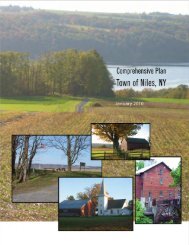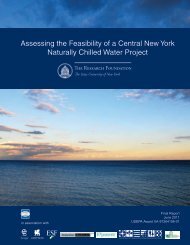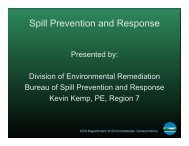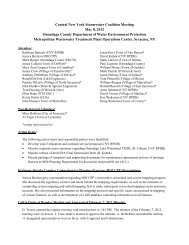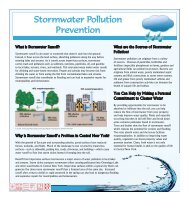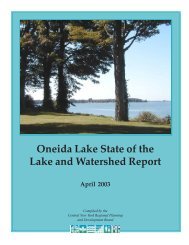A Management Strategy for Oneida Lake and its ... - CNY RPDB Home
A Management Strategy for Oneida Lake and its ... - CNY RPDB Home
A Management Strategy for Oneida Lake and its ... - CNY RPDB Home
Create successful ePaper yourself
Turn your PDF publications into a flip-book with our unique Google optimized e-Paper software.
Accomplishments<br />
Throughout the course of 12 months, the<br />
Working Group accomplished the following<br />
tasks:<br />
- Educational programs <strong>and</strong> opportunities<br />
were discussed at length <strong>for</strong> primary decisionmakers<br />
as well as the general public. Recommendations<br />
were developed to provide greater<br />
assistance to home <strong>and</strong> business owners prior<br />
to flooding <strong>and</strong> after the flooding has occurred.<br />
- Flooding definitions were developed <strong>for</strong><br />
improved communication among Working<br />
Group members. Because stakeholder groups<br />
frequently interpret the terms “flooding” <strong>and</strong><br />
“flood damage” differently, the Working<br />
Group defined levels of flooding <strong>and</strong> discussed<br />
methods to evaluate flood damage.<br />
Definitions were developed <strong>for</strong> nuisance high<br />
water, minor flooding, <strong>and</strong> major flooding<br />
levels in both US Geological Survey <strong>and</strong><br />
Barge Canal datum.<br />
- Working Group stakeholders were surveyed<br />
to determine the optimum numeric water level<br />
objectives <strong>and</strong> the in<strong>for</strong>mation was presented<br />
in graphic <strong>for</strong>mat.<br />
- There are many uses of the lake. The<br />
Working Group debated on whether water<br />
level management decisions should be made<br />
to facilitate tourism, recreation, fisheries <strong>and</strong><br />
wildlife habitat, commercial navigation, flood<br />
control, <strong>and</strong>/or boat launch <strong>and</strong> marina profitability.<br />
To learn more about this issue, a guest<br />
speaker from the United States Geological<br />
Survey (William Kappel) was invited to<br />
present to the Working Group. Diverse lake<br />
uses were considered when the recommendations<br />
were compiled.<br />
- The timing of water level fluctuations has a<br />
direct impact on lake ecology. Discussions<br />
focused on the challenging task of managing<br />
the lake water levels <strong>for</strong> maximum protection<br />
of aquatic habitat, while acknowledging<br />
diverse recreational uses <strong>and</strong> recognizing<br />
existing statute <strong>and</strong> liability concerns. A guest<br />
speaker from the Cornell Biological Field<br />
Station (Dr. Edward Mills) was invited to<br />
discuss aquatic impacts from water level<br />
fluctuations. The protection of aquatic habitat<br />
was considered when water level recommendations<br />
were developed.<br />
- Working Group members attended Fisheries<br />
Working Group meetings to facilitate communication<br />
<strong>and</strong> to discuss recommendations that<br />
were consistent between the two groups. The<br />
Fisheries Working Group was asked to<br />
coordinate with the F/WLM Working Group<br />
to establish water levels that are beneficial to<br />
fish habitat <strong>and</strong> spawning.<br />
- There was an initial lack of underst<strong>and</strong>ing<br />
among Working Group members regarding<br />
the control structures regulating water level in<br />
the lake. In response to this need, Howard<br />
Goebel, a representative from the New York<br />
State Canal Corporation, was invited to<br />
present in<strong>for</strong>mation on what structures are in<br />
place <strong>and</strong> who is responsible <strong>for</strong> their operation.<br />
- The Working Group reviewed the timing of<br />
the navigation regulations (the dates the NYS<br />
Canal Corporation begins <strong>and</strong> ends their<br />
control of the system each year) <strong>and</strong> evaluated<br />
the impacts of flooding in relation to the<br />
navigation season. Recommendations were<br />
based on these findings.<br />
- Accurate GIS mapping was identified by the<br />
Working Group as a critical need in order to<br />
evaluate the current flooding problems <strong>and</strong> to<br />
set water level goals. H. Goebel (NYS Canal<br />
Corporation) <strong>and</strong> S. Ingmire (Madison County<br />
Planning Department) researched current<br />
mapping capabilities <strong>and</strong> determined that there<br />
was insufficient coverage in the current digital<br />
elevation model (DEM) to provide a graphical<br />
Appendices page 87



